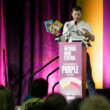And then it's spring
Description
Following a snow-filled winter, a young boy and his dog decide that they've had enough of all that brown and resolve to plant a garden. They dig, they plant, they play, they wait . . . and wait . . . until at last, the brown becomes a more hopeful shade of brown, a sign that spring may finally be on its way.Julie Fogliano's tender story of anticipation is brought to life by the distinctive illustrations Erin E. Stead, recipient of the 2011 Caldecott Medal. This title has Common Core connections. And Then It's Spring is one of The Washington Post's Best Kids Books of 2012.One of Kirkus Reviews' Best Children's Books of 2012
More Details
Similar Titles From NoveList
Similar Authors From NoveList
Published Reviews
Booklist Review
*Starred Review* A first-time author and the Caldecott Award-winning illustrator of A Sick Day for Amos McGee (2011) team up in this beautiful ode to a patient gardener. After the winter, you have brown, all around you have brown, but small hints of spring, like red robins and rain, hold promise. A young boy, joined by his dog companion, plants seeds, each labeled with a picture of carrots or sunflowers or peas. But as much as they wait, hope, and examine the dirt with a magnifying glass, there's no green to be found. Fogliano's simple, tender text has a solemn tone, which perfectly reflects the anticipatory state of the boy and his animal friends. The woodblock and pencil illustrations give life to animals so expressive and endearing it hurts, and the layout a mixture of full-bleed spreads and white-bordered vignettes paces the story well. A two-spread fantasy in the middle of the story in which the boy imagines birds pecking at the seeds or bears stomping on them is smile-inducing, particularly a scene of a befuddled bear with a planter on his head. But what's most fun to notice throughout are the small, subtle details on each page. It's not easy to wait . . . and wait . . . but children, like the boy, may realize that patience often yields big rewards. HIGH-DEMAND BACKSTORY: Fans of A Sick Day for Amos McGee and award-watchers, in general will be eagerly anticipating this, Stead's first children's book since winning the 2011 Caldecott Medal.--Kelley, Ann Copyright 2010 Booklist
Publisher's Weekly Review
Readers of Shaun Tan's The Red Tree will recognize the glum-to-radiant trajectory of Fogliano's soft-spoken debut, subtly illustrated by Caldecott Medalist Stead (A Sick Day for Amos McGee). Unfolding as a single sentence that carries readers from late winter to spring (almost every page opens with an "and," pushing things along), the story focuses on a boy in blank-eyed glasses, who slouches in barren farmland with a dog, a turtle, and other assorted animals and birds. "First you have brown,/ all around you have brown." The boy plants seeds in the packed earth and waits for the plants to grow. Worry and waiting are recurring themes: did birds eat the seeds? what about that trio of bears, seen happily ignoring the boy's "please do not stomp here" sign? Pale blue sky and tawny drabs flood Stead's block-print-and-pencil images, which yield not a sprout until the closing spread, "and now you have green,/ all around you have green." In an understated and intimate partnership, Fogliano and Stead conjure late winter doldrums and the relief of spring's arrival, well worth the wait. Ages 4-7. Illustrator's agent: Emily Van Beek, Folio Literary Management. (Feb.) (c) Copyright PWxyz, LLC. All rights reserved.
School Library Journal Review
PreS-Gr 2-"First you have brown.all around you have brown." A boy and his dog wait and wait in the gloom of late winter for the first signs of spring. Blue sweater and red pom-pom hat brighten an otherwise bleak landscape as the boy digs, plants, sows.and waits. Accompanied by his equally anxious pooch, a rabbit, a turtle, and a bird, he looks for some color of the season. "Is that a little green?," he wonders, wielding a magnifying glass to a small mound of dirt. "No, still brown." He also worries.have the birds eaten all the seeds? Has the bears' stomping crushed them? While the young gardener bemoans the fact that the bears can't read his "Please, no stomping" sign, viewers chuckle as one beast stretches and lazily scratches his underarm with the sign while another sits with a flowerpot on his head. A wish for rain works, resulting in a "hopeful, very possible sort of brown." An underground maze shows mice and worms readying the ground while a "greenish hum" fills the air. Then the sun shines brightly as the boy hangs a tire swing and sways patiently. Walking outside the next morning to greet the relentless brown, he is happily surprised-"And now you have green! All around you have green." Erin E. Stead's whimsical wood-block-and-pencil illustrations are gently animated, adding to Julie Fogliano's tender tale (Roaring Brook, 2012). The male narrator's voice reflects the characters' disappointment, hope, and joy when the much anticipated green finally and gloriously appears. An interview with the first time author reveals her Catskill Mountain inspiration and how she came to collaborate with Caldecott-winner Stead. Use to enrich units on spring, plants, or gardening.-Barbara Auerbach, P.S. 217, Brooklyn, NY (c) Copyright 2013. Library Journals LLC, a wholly owned subsidiary of Media Source, Inc. No redistribution permitted.
Horn Book Review
A small bespectacled boy and his companions, a dog, a rabbit, and a turtle, are on a search for spring. "First you have brown, / all around you have brown / then there are seeds / and a wish for rain, / and then it rains / and it is still brown, / but a hopeful, very possible sort of brown..." Fogliano's poetic yet grounded narrative is reminiscent of Charlotte Zolotow's picture-book texts in its understatement and straightforward, childlike observations. Her text builds the tension with an expertise of a much more experienced picture book writer, and she gets the pacing exactly right. As for the illustrations, there's no sophomore slump for Stead: her second book is even better than her 2011 Caldecott winner, A Sick Day for Amos McGee (rev. 5/10). The graceful illustrations were created with the same medium (woodblock prints with pencil), but here she's used a completely different palette of browns, grays, light blue, bright green, and touches of red, all set against negative space that most often suggests a cloudy sky. Observant readers will notice many humorous touches: the rabbit eagerly anticipating the first sign of carrots in the garden, the dog waiting for a bone he has planted to grow, a bird sunning itself under the garden label of a sunflower. But the humor never overshadows the mood of quiet anticipation or the thrill that comes at book's end when, all of a sudden, "now you have green, / all around / you have / green." kathleen t. horning From HORN BOOK, Copyright The Horn Book, used with permission.
Kirkus Book Review
ands, thats, commas and a boy's earnest concerns for his seeds, runs on, leaving readers waiting and waiting and waiting--just like the child gardener. The boy's oversized glasses, his tilted, blank face (we never see his eyes) and tiny chin melt hearts instantly. Stead wisely withholds his features, letting Fogliano's babbling stream of small worries and staggeringly sharp imaginings flesh him out. Silly bears might tread on the plantings, unaware of signs that read "please do not stomp here-- / there are seeds / and they are trying." Germinating seeds issue "a greenish hum / that you can only hear / if you put your ear to the ground / and close your eyes." This elaborate inner world and darling voice reverberate in muted wood-block prints and empathetic pencil illustrations as well, its timbre and tone unchanged. Delicate lines run like fine veins, describing animals, trees, plants and fences with intricate and intentional specificity. Sizable, scalloped cloud formations, whose flat panes of white widen double-page horizons, offset both the scrupulous line-work and abundant regions of brown and blue. Their simplicity ventilates these pictures, allowing readers to note amusing secondary animal activities in the dirt. Many treasures lie buried within this endearing story, in which humor and anxious anticipation sprout alongside one another. This sweet seedling will undoubtedly take root and thrive. (Picture book. 3-8)]] Copyright Kirkus Reviews, used with permission.
Booklist Reviews
*Starred Review* A first-time author and the Caldecott Award–winning illustrator of A Sick Day for Amos McGee (2011) team up in this beautiful ode to a patient gardener. After the winter, "you have brown, all around you have brown," but small hints of spring, like red robins and rain, hold promise. A young boy, joined by his dog companion, plants seeds, each labeled with a picture of carrots or sunflowers or peas. But as much as they wait, hope, and examine the dirt with a magnifying glass, there's no green to be found. Fogliano's simple, tender text has a solemn tone, which perfectly reflects the anticipatory state of the boy and his animal friends. The woodblock and pencil illustrations give life to animals so expressive and endearing it hurts, and the layout—a mixture of full-bleed spreads and white-bordered vignettes—paces the story well. A two-spread fantasy in the middle of the story—in which the boy imagines birds pecking at the seeds or bears stomping on them—is smile-inducing, particularly a scene of a befuddled bear with a planter on his head. But what's most fun to notice throughout are the small, subtle details on each page. It's not easy to wait . . . and wait . . . but children, like the boy, may realize that patience often yields big rewards. HIGH-DEMAND BACKSTORY: Fans of A Sick Day for Amos McGee—and award-watchers, in general—will be eagerly anticipating this, Stead's first children's book since winning the 2011 Caldecott Medal. Copyright 2011 Booklist Reviews.
Publishers Weekly Reviews
Readers of Shaun Tan's The Red Tree will recognize the glum-to-radiant trajectory of Fogliano's soft-spoken debut, subtly illustrated by Caldecott Medalist Stead (A Sick Day for Amos McGee). Unfolding as a single sentence that carries readers from late winter to spring (almost every page opens with an "and," pushing things along), the story focuses on a boy in blank-eyed glasses, who slouches in barren farmland with a dog, a turtle, and other assorted animals and birds. "First you have brown,/ all around you have brown." The boy plants seeds in the packed earth and waits for the plants to grow. Worry and waiting are recurring themes: did birds eat the seeds? what about that trio of bears, seen happily ignoring the boy's "please do not stomp here" sign? Pale blue sky and tawny drabs flood Stead's block-print-and-pencil images, which yield not a sprout until the closing spread, "and now you have green,/ all around you have green." In an understated and intimate partnership, Fogliano and Stead conjure late winter doldrums and the relief of spring's arrival, well worth the wait. Ages 4–7. Illustrator's agent: Emily Van Beek, Folio Literary Management. (Feb.)
[Page ]. Copyright 2011 PWxyz LLCSchool Library Journal Reviews
PreS-Gr 2—The lowercase letters in the title and the theme immediately bring to mind "in just spring" by e. e. cummings. That association continues while experiencing the book's economy of words and construction as a single, lyrical rumination (one initial capital letter; one concluding period). If that earlier poem celebrates the fullness of the season, this one re-creates the moment before—the faith-hope-doubt-worry stage that a gardener experiences after planting: "First you have brown,/all around you have brown…." A bundled and bespectacled boy, his dog, a rabbit, and a turtle, all sporting red knit hats, survey the barren soil, bare trees, and dried stalks. Stead's warm, finely textured scenes, printed from wood blocks and enhanced with pencil, are imbued with realism and quiet humor. The second-person narrative and immediately recognizable emotions pull readers close, as do the delicate details and nuanced expressions that grace the interplay between the characters and their subtly changing surroundings. Fogliano takes seriously the concerned flights of fancy a child conjures while enduring the interminable progress of a seed: "…maybe it was the bears…/because bears can't read signs/that say things like/ 'please do not stomp here—/there are seeds/and they are trying….'" Children will intuitively relate to both the agony of anticipation and the effort of growing. This seemingly real-time experience of getting to green is a droll, wistful ode to the stamina behind wanting, will, and perseverance.—Wendy Lukehart, Washington DC Public Library
[Page 74]. (c) Copyright 2011. Library Journals LLC, a wholly owned subsidiary of Media Source, Inc. No redistribution permitted.





























